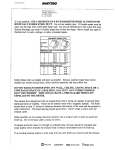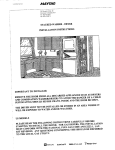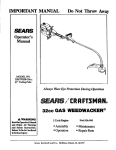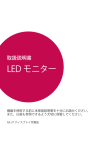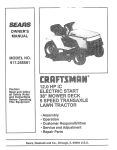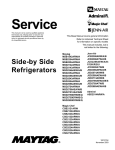Download Whirlpool CWG3100AAE - 24 Inch Single Gas Wall Oven Installation manual
Transcript
240Edwards Street.SE C]eveiand. Tennessee _7211 Tel:423-,-t72-3333 Fax:423-473-6710 GAS INSTALLATION MANUAL SEALED TOP BURNERS 30" WIDE SELF-CLEAN FREESTANDING INSTALLER: AND SLIDE-IN-RANGES LEAVE THESE INSTRUCTIONS WITH THE APPLIANCE. PLFASE KEEP THIS MANUAL FOR FUTURE REFERENCE. This manual is intended to assist in the initial installation and adjustments of the range. YOUR RANGE MAY NOT BE EQUIPPED WITH SOME OF THE FEATURES REFERRED TO IN THIS MANUAL. SPECIAL WARNING ONLY QUALIFIED PERSONNEL SHOULD INSTALL OR SERVICE THIS RANGE. READ SAFETY INSTRUCTIONS IN USE AND CARE BOOK BEFORE USING THE RANGE. J_ .MAYI'AG Ac_rnir_t Yl *--r-_. a_._N-,t_dl= "_iacji<: C.",et 240E(;war_s Street,SE C',eveiand, Tannessee 37311 Tel:423-472-_333 Fax: _23-._78-_71D SECTION 1 INSTALLATION A. SERVICE - PARTS INFO1LMATION WHEN YOUR RANGE REQUIRES SERVICE OR REPLACEMENT PARTS, CONTACT YOUR DEALER OR AUTHORIZED SERVICE AGENCY. PLEASE GIVE THE COMPLETE MODEL AND SERIAL NUMBERS OF THE RANGE WHICH IS LOCATED ON THE RANGE MODEL NUMBER PLATE. NOTE: THE RANGE MODEL NUMBER PLATE IS LOCATED ON THE LOWER FRONT FRAME OF THE RANGE. B. CODES. These units must be installed to conform with all local codes, rules and regulations including municipal, provincial and state building codes, as well as local utility regulations. Ranges approved for Canada will have the Canadian Gas Association (CGA) approval seal on the model number plate. Ranges approved for Canada have been tested to insure compliance with CGA 1.1. ELECTR/C SUPPLY The range must be installed in accordance with Local and National Electric Code (NEC) ANSI/NFPA No. 70-1987. In Canada the range must be installed in accordance with the current CSA Standard C22.1Canadian Electrical Code Part 1. GAS SUPPLY Installation of this range must conform with local codes or, in the absence of local codes, with the National Fuel Gas Code, ANSIZ223.1-1988. In Canada the range must be installed in accordance with the current CGA Standard CAN/CGA-B149-Installation Codes tbr Gas Burning Appliances and Equipment and/or local codes. Check the range model number plate to see if the range is approved for installation in mobile homes and/or recreational vehicles. If approved the following items are applicable. Customer Ser',rica __ 248Edwards Street,SE C]e,:e]and. Tennessae 37311 Te;::;23-472-,3.333 Fax:423-478-67;0 MOBILE HOMES The installation of a range designed for mobile home installation must conform with the Manufactured Home Construction and Safety Standard, Title 24 CFR, Part 3280 (formerly the Federal Standard for Mobile Home Construction and Safety, Tide 24 HUD, Part 280) or, when such standard is not applicable, the Standard for Manufactured Home Installations 1982 (Manufactured Home Sites, Communities and Set-Ups), ANSIA225. i-t984, or with local codes. In Canada, the range must be installed in accordance with the current CSA Standard C22.1-Canadian Electrical Code Part 1 and Section Z240.4.1-Installation Requirements for Gas Burning Appliances in Mobile Homes (CSA Standard CAN/CSA -Z240MH). RECREATIONAL VEHICLES The installation of a range designed for recreational vehicles must conform with state or other codes or, in the absence of such codes, with the Standard for Recreational Vehicles, ANSI A119.2-1982. In Canada the range must he installed in accordance with Section C22.2 No. 148/CAN/CSA-Z240.6.2-Electrical Requirements for R.V. 's (CSA Standard CAN/CSEZ240RV Series) and Section Z240.4.2-Installation Requirements for Propane Appliances and Equipment in R.V.'s (CSA Standard CAN/CSA-Z240 RV Series. C. CLEARANCE DIMENSIONS (See back page for installation drawings). All free-standing ranges can be installed with the back against a vertical combustible wail, and the sides below the cooking surface against combustible base cabinets. Slide-in ranges must be installed in accordance with figure 10C. For complete information in regard to the installation of wail cabinets above the range and clearances to combustible wails above the cooking top see the installation drawings (back pages) and/or the Model Number Plate on the range. For SAFETY CONSIDERATIONS do not install a'range in any combustible cabinetry which is not in accord with the installation drawings and the clearance given on the range Model Number Plate. CAUTION: GUARD. DO NOT LIFT OR MOVE RANGE BY DOOR HANDLES, OR BACK- D. LOCATING THE RANGE. Do not set range over holes in the floor or other locations where it may be subject to strong drafts. Any opening in the wall behind the range and in the floor under the range should be sealed. Make sure the flow of combustion or ventilation air is not obstructed. Be certain all packing materials are removed from the range before operating to prevent fire tt_._I,A"tTAG _l_mll'al 71 _,.,ilEi_lN.,i'tlll "_"iafk: e,"tt 240 EdwardsStreet,SE CEeveiand, Tennessee37311 Tet: 423472-3333 Fax::t23-478-67;O or smoke damage should the packing material ignite. NOTE: A range should NOT be installed directly over kitchen carpeting unless an insnladng pad or I/4" thick piece of plywood is placed between the range and carpet. COPIES OF THE STANDARD LISTED ABOVE MAY BE OBTAINED FROM: NATIONAL FIRE PROTECTION ASSOCIATION Batterymarch Park Quincy, MA 02259 COPIES OF THE STANDARD LISTED ABOVE MAY BE OBTAINED FROM: AMERICAN GAS ASSOCIATION 1515 Wilson Boulevard Arlington, VA 22209 E. ANTI-TIP DEVICE INSTALLATION INSTRUCTIONS NOTE: A risk of rant tip over exist if the appliance is not installed in accordance with the installation instructions provided. The proper use of this device minimizes the risk of TIPOVER. In using this device the consumer must still observe the safety precautions as stated in the USE AND CARE MANUAL and avoid using the oven door and/or lower drawer as a step stool. Installation instructions are provided for wood and cement in either floor or wall. Any other type of constructions may require special installation techniques as deemed necessary to provide adequate fastening of the ANTI-TIP bracket to the floor or wall. Step 1 - Locating the Bracket A, Mark the floor or wall where either the right or left "EDGE" of the 30" opening is to be located. B. Place the BRACKET SIDE, see figure 1, at the marked "EDGE" and against the back wall. C. Use the bracket as a template and mark the required holes, as shown in figure 1, for the type of construction you will be using. Step 2 - Anti-Tip Bracket Installation A. Wood Construction: 1. Floor: Located the center of the two holes identified in figure 1 as "FLOOR-WOOD'. Drill a 1/8" pilot hole in the center of each hole (a nail or awl may be used if a drill is not _'_l ,MA_]'AG Admiral 7| zaui,_,JE N N -A_I:_ "i:_._a_j J¢ C,_.¢f _ustomerService ..__ 240_c.wards Street.SE CleveJand. Tennessee 3731 Tei:a22-_.72-3333 Fax:a23-478-_0 available). Secure the ANTI-TIP bracket to the floor with the two screws provided. Proceed to Step 3. 2. Wall: Locate the center of the two holes identified in figure I as "WALL-PLATE'. Drill an angled 1/8" pilot hole in the center of each hole as shown in figure 2. (A nail or awl may be used if a drill is not available). Secure the ANTI-TIP bracket to the wail with the two screws provided as shown in figure 2. Proceed to STEP 3. B. Cement or Concrete Construction: i. Suitable screws for concrete construction can be obtained at the hardware store. Drill the required size hole for the hardware obtained into the concrete at the center of the holes identiffed in figure 1 as "FLOOR-CEMENT". Secure the ANTI-TIP bracket to the floor. Proceed to STEP 3. Step 3 - Range Installation A. Complete the installation of the range per the installation instructions provided with the product. B. Align the range to its designated location and slide it back into position. Note: A minimum clearance of 1/4" is required between the range and the leveling foot that will engage the ANTI-TIP bracket, see figure 2. C. For SAFETY CONSIDERATIONS as well as optimum performance adjust the range so that it is level. This may be checked by placing a spirit level or a large pan of water on the cooktop or the oven rack. If an adjustment is required pull the range forward, tip the range and rotate the leveling feet as required. D. To check the range for proper installation of the anti-tip bracket: Use a flashlight and look underneath the bottom of the range to see that one of the rear leveling legs is engaged in the bracket slot. E. Proceed with the remainder of the instailation instructions provided with the range. 248 EdwardsStreet,SE Cleveland,Tennessee37,311 Tel: 423-J72-3333 Fax:_t23-478-BTtO GUn-E • 1/4 N M_ F . / PLATE ,_, ,=,,-7,, F]GURE2 , 11]; ._.'_TA6 Admiral71 _E._N-_ _aejic C.._et Cu,_0mer _r_ice A0t][A'_.r_/_G 2aOEdwards Street,SE C1evelanar Tennessee ,37311 Tei:423-472-3323 Fax:423-478-571 [3 F. CONNECTING THE RANGE 1. ELECTRICAL SUPPLY CONNECTION: The range requires 120 volts, 60 cycle alternating current from an outlet capable of supplying I5 amperes. WARNING: ELECTRICAL GROUNDING INSTRUCTIONS. This appliance is equipped with a three-prong grounding plug for your protection against shock hazard and should be plugged directly into a properly grounded receptacle. Do not cut or remove the grounding prong from this plug WARNING: DISCONNECT ELECTRICAL SUPPLY BEFORE SERVICING THE APPLIANCE. 2. GAS SUPPLY CONNECTION: A TRAINED SERVICEMAN MUST MAKE THE GAS INSTALLATION. a. A GAS CUTOFF VALVE SHOULD BE PUT IN AN ACCESSIBLE LOCATION IN THE SUPPLY LINE AHEAD OF THE RANGE, FOR TURNING ON AND TURNING OFF GAS SUPPLY. If range is to be connected to house piping with flexible or semirigid metal connectors for gas appliances, CONNECTOR NUTS MUST NOT BE CONNECTED DIRECTLY TO PIPE THREADS. THE CONNECTOR MUST BE INSTALLED WITH ADAPTORS PROVIDED WITH THE CONNECTOR. b. The house piping and/or range connector used to connect the range to the main gas supply must be CLEAN, free of metal shavings, rut, dirt, and liquids (oil or water). Dirt, etc. in the supply lines can work its way into the range manifold and in turn cause failure of the gas valves or controls and clog burners and/or pilot orifices. NOTE: THE MAIN TOP DOES NOT LIFT UP. c. Turn off all pilots and main gas valve of other gas appliances. d. Turn off main gas valve at meter. e. Before connecting range, apply pipe thread compound approved for LPG to all threads. f. Connect range to gas supply at regulator using rigid pipe or adaptors supplied with flexible connector. See rating plate for type of gas range has been manufactured for. Gas conversion kits are available. g. Turn on main gas valve at meter, and relight pilots at other gas appliances. h. Apply soap suds to the gas connection at range and check for leakage. Check for leakage at all gas connections and fittings in the range. CAUTION: NEVER CHECK FOR LEAKS WITH A FLAME. i. Connect electric supply cord to wall receptacle 120 volt, 60 cycle alternating current, at 15 amperes. 240Eawa_s S[reet SE C_e_eian_, Tennessee37311 Te!:422472-23S3 Fa×:a23-_78-67iO j. Adjust burner air shutter to the widest opening that will not cause the flame to lift or blow off the burner when cold. NOTE: Correctly adjusted sealed burners will blow off without a pot over the burner. could be adjusted with a pot in place. FIGURE Regulator 4 L,j These "_"_"_ & Connection G. CHECKING MANIFOLD GAS PRESSURE If it should be necessary to check the manifold gas pressure, remove right rear burner assembly by placing a burner wrench (part number 8002P026-60, available from your dealer or authorized service agency ) over surface burner assembly with ignitor positioned inside gap in wrench ring (figure 5A). This prevents ignitor from being crushed when wrench tightens on burner assembly. Rotate burner assembly approximately one-eighth turn counterclockwise and lift from main top (figure 5B). Connect manometer (water gauge) or other pressure device to the top burner right rear orifice hood, using a rubber hose with inside diameter of approximately 1/4", hold tubing down tight over orifice hood. Turn burner on. For an accurate pressure check have at least two (2) other top burners burning. Be sure the gas supply (inlet) pressure is at least one inch (1 ") above specified range manifold pressure. The gas supply pressure should never be over 14 inches water column. When properly adjusted for Natural Gas the water column pressure is 4_ , for LP Gas the water column pressure is 10". Replace burner assembly in main top and rotate approximately one-eighth turn clockwise using burner wrench until burner locks into position with ignitor facing rearward. FIGURE5A FIGURE_ 5B _ _MAYrAG &dmtral _'! re,dE N N -,i_dl_ _Ji_ C,._ef 240Edwaras Street,SE C',eveland, Tennessee 37311 Tel:423-472-2333 Fax:.222-,.t78-87!0 H. CHECKING PRESSURE OF HOUSE PIPING SYSTEM 1. The appliance and its individual shutoff valve must be disconnected from the gas supply piping system during any pressure testing of that system at test pressures in excess of 1/2 pound/sq, in. (3.SkPa) (13.8 in. water column). 2. The appliance must be isolated from the gas supply piping system by closing its individual manual shutoff valve during any pressure testing of the gas supply piping system at test pressures equal to or less than 1/2 pound/sq.in. (3.5kPa) (13.8 in. water column). 2_0Edwards Street SE C',evelan& Tennessee 37311 Te!:-123-a72-3333 F_x:423-478-87i0 SECTION II RANGE ADJUSTMF.NTS A. TOP SECTION - ELECTRIC IGNITION To operate, push andturn top burner knob to the LITE position. The top burner will light. To turn OFF spark after the top burner has ignited: 1. For ranges with SINGLE purpose valves, turn knob to the right, clockwise to the HI setring, figure 6A. 2. For ranges with HI-SIM-WARM valves, turn knob, either direction to HI setting, figure 6B. FIGURE 6A Slngle Purpose Knob FIGURE 6B Hi--Sire-Warm Knob 3. There are separate ignition devices for each burner. These ignitors are turned "on" when any knob is turned to the LITE setting. The ignitors will "spark" as long as any of the top burner knobs are at the LITE setting. In case of an electrical power failure, the top burners can still be used. To light a burner, hold a lighted kitchen match adjacent to the top burner to be used an turn valve knob for the burner to LITE. USE EXTREME CAUTION. The electric ignitor will not come "on". It is necessary when using the top burners during this type of emergency to light each burner to be used with a kitchen match as describe above each and every time the burner or burners are to be used. B. OVEN ADJUSTMENTS 1. ELECTRIC IGNITION-BAKE BURNER WITH ELECTRIC GLOW BAR a. The bake burner is equipped with an electric control system as well as an electric oven burner ignitor. This control system requires NO adjustment. To operate, turn thermostat knob to any temperature setting or to broil. Current will flow to the ignitor. It will _glow" similar to a light bulb. (This glow may be reflected into the oven through the openings in the oven bottom). When the ignitor has reached a temperature sufficient to ignite gas, the electrically controlled oven valve will open and flame will appear at the oven burner. There is a time lapse from 30 to 45 seconds after the thermostat is turned ON before flame appears at the oven burner. When the oven has reached the dial setting, the glowing ignitor will go 240Edwards Street.SE Cleveland. Tennessee $73IT Tel:423-472-3333 Fax:4.23-478-67_Q OFF. The burner flame will go "out" in 20 to 30 seconds after the ignitor goes "OFF". To maintain any given oven temperature this cycle will continue as long as the dial (or display) is at the given temperature. b. In case servicing should become necessary, a manual gas valve is supplied on the pressure regulator to shut off the gas to the oven and broiler burner only. (See figures 3 and 4). c. The oven CANNOT be used during periods of power outage. In case of power failure, turn the thermostat to the OFF position. 2. AIR SHUTTER-OVEN BURNER a. The approximate length of the flame on the oven burner is 1/2" (distinct inner, blue flame). See figure 7. FIGURE 7 b. Oven burner flame can be checked as follows, without burner baffle in place: - Yellow flame on burner-open air shutter "2" on figure 8. - Distinct blue flame but lifting-close air shutter "2" on figure 8. c. The air shutter, figure 8, should be set approximately 2/3 open for natural gas and full open on LP gas. LOC3( SC_ AIR SHUTTER " ORIFIC t= HOOD 72 RGURE 3. WAIST-HI BROILER BURNER (seefigure 9) a. The waist-hi broiler is equipped with its own (separate) electric control system and electric broiler burner ignitor. To operate turn oven thermostat knob to the BROIL setting, The system functions the same as described under Bake Burner. b. A manual gas shut-off valve is supplied, on regulator in case servicing should become necessary. See figure 4. 2_.0EdwardsStreet. SE Cleveland,Tennessee37311 Tel: 423-472-3332 Fax:_.23-478-6710 c. The air shutter adjustments are the same as illustrated in figure 8. The approximate length of the flame of the broil burner is a distinct inner blue flame of 3/8 inch. The outer flame will extend outward as a sheet of flame adjacent to the burner baffle (flame spreader) above the broil burner, figure 9. The air shutter, figure 8 should be set to full open on both natural and on LP gas. d. The waist -hi broiler CANNOT be used during periods of power outage. In case of power failure, turn thermostat to the OFF position. C. CLEAN CYCLE-SEE USE & CARE MANUAL FOR SELF CLEAN INSTRUCTIONS. 240Edwards StresI.SE C_eveland. Tennessee 27311 Tei:423-472-3333 Fax:423-478-571G SECTION IH GAS CONVERSION A. GENERAL All sealed burner ranges and cooktops are equipped with double coaxial (universal) orifices and with a convertible gas regulator. The unit model number plate states which gas it was adjusted for at the factory. To convert the unit to either Natural gas or LP gas will require adjustment of the surface burner orifice hoods, adjustment of the oven orifice/air shutter and replacement and/or adjustment of the pressure regulator converter cap. B. REGULATOR CONVERSION The unit regulator must be set to match the type gas supply used. If converting from natural gas to LP gas, the regulator must be converted to regulate LP gas. If converting from LP gas to natural gas, the regulator must be converted to regulate to natural gas. TO CONVERT THE PRESSURE REGULATOR FROM ONE GAS TO ANOTHER, DO EITHER (1) (2) OR (3) BELOW: YOUR _ WILL BE EQUIPPED WITH ONE OF THE THREE REGULATOR TYPES SHOWN BELOW. F_GURE 10 FIGURE11 RGURE12 I. Remove the cap, push down and turn counter clockwise. Turn the cap over and reinstall (figure 10). NOTE: THE GAS TYPE YOU ARE CONVERTING TO MUST BE VISIBLE ON THE TOP OF THE INSTALLED REGULATOR CAP. 2. Remove plastic dust cover from cap nut on top of regulator. Remove cap nut from regulator (plastic dust cover comes off with nut). "IMPORTANT" remove plastic dust cover from cap nut and reinstall on opposite side of cap nut. 240Edwards Street.SE Uevetand, Tennessee 3731_ Te]:a22-_72-3233 Fax:423-478-a710 Reinstall cap nut to regulator and replace dust cover. "CAUTION" be sure marking for the type of gas to which regulator has been converted is visible in top of cap nut before replacing plastic dust cover. See figure 11. 3. Remove cap and forcibly snap out plastic plunger from bottom of cap. Turn plunger over and forcibly snap back in origina/location (figure 12). NOTE: PLUNGER MIDST SNAP INTO POSITION; THE GAS TYPE YOU ARE CONVERTING TO MUST BE VISIBLE ON LOWER SIDE OF PLUNGER. C. ORIHCE CONVERSION 1. FROM NATURAL GAS TO LP GAS: a. Place burner wrench (part number 8002P026-60, available from your dealer or authorized service agency) over surface burner assembly with ignitor positioned inside gap in wrench ring (figure 13A). This prevents ignitor from being crushed when wrench tightens on burner assembly. Rotate burner assembly approximately one-eighth turn counter-clockwise and lift from main top (figure 13B). Using a 1/2" deep-well socket, tighten each burner orifice hood approximately two complete turns clockwise TO THE CLOSED POSITION. Replace burner assembly in main top and rotate approximately one-eighth turn clockwise using burner wrench until burner locks into position with ignitor facing rearward. b. On ranges, use the 1/2" open end wrench to tighten the oven orifice hood (1-figure 18) approximately two complete turns clockwise TO THE CLOSED POSITION. See figure 14B. c. Adjust burner air shutter to the widest opening that will not cause the flame to lift or blow off the burner when cold. NOTE: Correctly adjusted sealed burners will blow off without a pot over the burner. These should be adjusted with a pot in place. OlaF'7UE t-lOOO 24(]Edwar6s Street.SE C!eve[an_, Tennessee 37311 Te_:J22-472-3333 Fax:423-,,t' 7_,-_710 2. FROM LP GAS TO NATURAL GAS: a.Place burner wrench (part number 8002P026-60, available from you dealer or authorized service agency) over surface burner assembly with ignitor positioned inside gap in wrench ring (figure 13A). This prevents ignitor from being crushed when wrench tightens on burner assembly. Rotate burner assembly approximately one-eighth turn counter-clockwise and lift from top (figure 13B). Using a 1/2" deep-well socket, loosen each burner orifice hood approximately two complete turns counter-clockwise. Replace burner assembly in main top and rotate one-eighth turn clockwise using burner wrench until burner locks into position with ignitor facing rearward. b. On ranges, use the 1/2" open end wrench to loosen the oven orifice hood (1-figure 18) approximately tow complete turns counter-clockwise until the flames on the burner do not increase in length. See figure 14A. e. Adjust burner air shutter to the widest opening that will not cause the flame to lift or blow off the burner when cold. NOTE: Correctly adjusted sealed burners will blow off without a pot over the burner. These should be adjusted with a pot in place. ORIFICE HO00 OItlFIC._ HOOD RGURE 14A NATURAL GAS S_"iIING _ JL_L_G FIGURE 14B LP GAS S z'"J'1ING ACm, ir-3t _'1 .;,,,,_.L_..:E."4 N-,,_ "..,7-." .,., ,¢ '*'da,,;jc ¢,,_f 240E_ardsStreeLSE Cleve!and. Tennessee 37311 Tei:423-_72-3333 Fa×:_23_478-57W D. TOP BURNER "WARM" ADJUSTMENT If equipped with a single purpose valve (see figure 15) no adjustment is required. If equipped with HI, SIM, WARM valves, the burner flame at the WARM position should extend to the outer edge of the lip of the burner cap. The WARM setting should be such that a stable flame is maintained on the burner when turning the knob from HI to WARM. If it should be necessary to increase or decrease the flame at the WARM setting, operate burner at HI position for approximately five minutes. Turn knob to WARM (see figure 16). Remove valve handle and with a small screwdriver make the desired adjustment by turning adjustment screw "a" (figure 16). Check each top burner at the WARM position for flame size. FIGURE 15 FIGURE 16 E. OVE,N BURNER AIR SHUTTER ADJUSTMENT The approximate length of the distinct inner blue flame of the oven burner is 1/2" (figure 17). Remove the burner baffle to adjust the burner flame with the air shutter. The air shutter (figure 18) should be approximately 2/3 open for natural gas and approximately full open on LP gas. If the oven burner flame is yellow, open the air shutter until it is distinct and blue. If the oven burner flame is distinct and blue but lifting, close the air shutter until the lifting stops. FIGURE 17 LOCK SCREW 3 \ AIR SHUTTER ORIFICE HOOD /,..2 RGURE 18 Z4OEdwards Stmet,SE C;eve[and, Tennessee 3733; Teh42S-472-3233 £ax:_23-478-5710 SECTION IV INSTALLATION FREE STANDING DRAWINGS RANGES Range may be installed with zero inches clearance adjacent to (against) combustible construction at the rear and on the sides below the cooktop. For clearance for wail cabinets above a free-standing conventional range cooktop see illustration and dimensions given below. Wall cabinets can be installed above and adjacent to a range, with elevated oven as illustrated. NOTE: 30 inch dimension between cooking top and wail cabinet shown on illustration does not apply to ranges with an elevated oven. The 30 inch dimension may be reduced to not less than 24 _ when the wail cabinets in a domestic home are protected with fireproof materials in accordance with American National Standards-National Fuel Gas Code or in mobile homes when they are protected with fireproof materials in accordance with the Manufactured Home Construction and Safety Standard (see Section 1 (B) codes). CAUTION: Some cabinets and building materials are not designed to withstand the heat produced by the normal safe operation of a listed appliance. Discoloration or damage, such as delamination, may occur. 240Edwards Street.SE Cleveland, Tennessee 2731: Tel:423472-3333 Fax:4_3-478-6710 TABLE NO. I DIMENSION A WIDTH OF RANGES DIMENSION B NO LESS THAN WIDTH OF RANGES DIMENSION O 30" Free Standing, Self Clean 30 "°` 30" 3" Rgure 19B 30" Slide-in, Self Clean 30"** 30" 3_o F_gure19C RANGE SERIF-.SNUMBER FOR DIMENSIONS LOWER OABINL¢:% " DEPTH & CUTOUT A, B & C- SEE TABLE NO. 1 FRONT VIEW OETA!L oF RGURE 19A INSTALLATION ILLUSTRATION FREE STANDING RANGES 24GEcwarosStr_e[,SE Cleveiane,Tennessee37311 TeL_23472.3323 Fax:_23478-6710 WAL_ • _ RL_4 ¢O_L£T_ RGURE _-" f _ COOK TOP. "-...J ' _ aE El IN. 198 Gas Free-Standing Ranges OVEN I BRCILER 1 CUTOUT DIMEHSIONS APPROX. SHIPPfNG NOLO: 5--TI_.ORKKOII_C¢_R0 _--.-/ RGURE 10 ¢_,F.JI, R TO_, X-"--..- 19C Gas $lide-_n Ranges OVEI,I I , W1°TIt BROILER H_IGWr I CUTOUT DIMENSIONS SHIPPING APPROX.



















